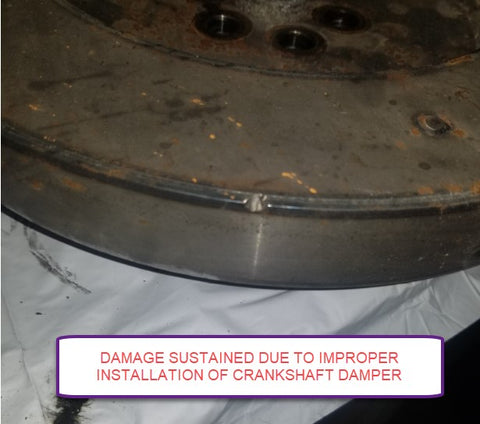We at KLM Performance are always happy to provide technical assistance. We recently received a call from an individual and they wanted to know if the damper could have been the cause of the premature wear on the main bearings. The main bearings, along with the crankshaft damper, were replaced at his recent in-frame engine overhaul.
For those not familiar with engine internals, the main bearings hold the crankshaft in place and allow it to rotate within the engine block. Main bearings are held in place by the engine block and bearing caps.
Although this customer had not previously purchased products with KLM Performance, we wanted to do all we could to help (we have found this type of service often pays future dividends). We asked the customer to provide us with some more details, and upon receipt of the pictures and consultation with the damper manufacturer, Vibratech TVD, we came to the following conclusion. The Crankshaft damper had a noticeable deformation on the outside edge. We asked if the damper was dropped during the installation process. The answer was yes, his mechanic did drop the crankshaft damper, and that was the cause of the ding in the outer casing.
What Vibratech TVD recommends is not to install any viscous damper that has been dented or shows damage to the outer housing. As shown in the damper cut-away image below, there is an internal inertia ring that shears through viscous silicone, This shear action is what allows the damper to properly absorb the crankshaft twist energy, thus alleviating the torsional vibrations of the engine. The area between the outer casing and the inertia ring is called the "shear gap". This is where the silicone fluid is injected. This shear gap is between .005"-.010" (a human hair is .003"). Therefore, any damage to the outer housing can compromise the inertia ring's ability to move freely. If the external housing damage is severe enough, it will lock the internal inertia ring in a fixed position. If the inertia ring can no longer freely rotate, it will cause a rotating assembly imbalance and lead to increased bearing/component wear and ultimately catastrophic engine failure.

The images below show a damper that was installed on a Cummins N14 engine after an in-frame overhaul. The crankshaft damper has a significant dent in the outer housing, which caused the casing to impede the inertia ring's rotation, rendering the damper ineffective in controlling the vibrations. This engine was run for approximately two months and now needs to have the following work completed to get the engine back on the road.
#1 Line Bore the engine block
#2 Inspection of all rotating assembly components including crankshaft for structural defects. Replacement of any components showing excessive wear.
#3 Install new crankshaft bearings.
#4 Inspection and replacement of motor mounts.


